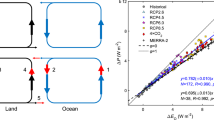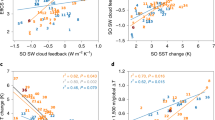Abstract
An influence of solar irradiance variations on Earth’s surface climate has been repeatedly suggested, based on correlations between solar variability and meteorological variables1. Specifically, weaker westerly winds have been observed in winters with a less active sun, for example at the minimum phase of the 11-year sunspot cycle2,3,4. With some possible exceptions5,6, it has proved difficult for climate models to consistently reproduce this signal7,8. Spectral Irradiance Monitor satellite measurements indicate that variations in solar ultraviolet irradiance may be larger than previously thought9. Here we drive an ocean–atmosphere climate model with ultraviolet irradiance variations based on these observations. We find that the model responds to the solar minimum with patterns in surface pressure and temperature that resemble the negative phase of the North Atlantic or Arctic Oscillation, of similar magnitude to observations. In our model, the anomalies descend through the depth of the extratropical winter atmosphere. If the updated measurements of solar ultraviolet irradiance are correct, low solar activity, as observed during recent years, drives cold winters in northern Europe and the United States, and mild winters over southern Europe and Canada, with little direct change in globally averaged temperature. Given the quasiregularity of the 11-year solar cycle, our findings may help improve decadal climate predictions for highly populated extratropical regions.
This is a preview of subscription content, access via your institution
Access options
Subscribe to this journal
Receive 12 print issues and online access
$259.00 per year
only $21.58 per issue
Buy this article
- Purchase on Springer Link
- Instant access to full article PDF
Prices may be subject to local taxes which are calculated during checkout




Similar content being viewed by others
References
Gray, L. J. et al. Solar influences on climate. Rev. Geophys. 48, RG4001 (2010).
Labitzke, K. Sunspots, the QBO, and the stratospheric temperature in the north polar region. Geophys. Res. Lett. 14, 535–537 (1987).
Kodera, K. On the origin and nature of the interannual variability of the winter stratospheric circulation in the northern hemisphere. J. Geophys. Res. 100, 14077–14087 (1995).
Kodera, K. & Kuroda, Y. Dynamical response to the solar cycle. J. Geophys. Res. 107, 4749 (2002).
Matthes, K., Kuroda, Y., Kodera, K. & Langematz, U. Transfer of the solar signal from the stratosphere to the troposphere: Northern winter. J. Geophys. Res. 111, D06108 (2006).
Shindell, D. T., Schmidt, G. A., Miller, R. L. & Rind, D. Northern Hemisphere winter climate response to greenhouse gas, ozone, solar, and volcanic forcing. J. Geophys. Res. 106, 7193–7210 (2001).
Schmidt, H., Brasseur, G. P. & Giorgetta, M. A. Solar cycle signal in a general circulation and chemistry model with internally generated quasi-biennial oscillation. J. Geophys. Res. 115, D00I14 (2010).
Tsutsui, J., Nishizawa, K. & Sassi, F. Response of the middle atmosphere to the 11-year solar cycle simulated with the whole atmosphere community climate model. J. Geophys. Res. 114, D02111 (2009).
Harder, J. W., Fontenla, J. M., Pilewskie, P., Richard, E. C. & Woods, T. N. Trends in solar spectral irradiance variability in the visible and infrared. Geophys. Res. Lett. 36, L07801 (2009).
Haigh, J. D. A GCM study of climate change in response to the 11-year solar cycle. Q. J. R. Meteorol. Soc. 125, 871–892 (1999).
Haigh, J. D., Winning, A., Toumi, R. & Harder, J. W. An influence of solar spectral variations on radiative forcing of climate. Nature 467, 696–699 (2010).
Lean, J. Evolution of the sun’s spectral irradiance since the Maunder minimum. Geophys. Res. Lett. 27, 2425–2428 (2000).
Krivova, N. A., Solanki, S. K., Wenzler, T. & Podlipnik, B. Reconstruction of solar UV irradiance since 1974. J. Geophys. Res. 114, D00I04 (2009).
Garcia, R. R. Atmospheric physics: Solar surprise? Nature 467, 668–669 (2010).
Hewitt, H. T. et al. Design and implementation of the infrastructure of HadGEM3: The next-generation Met Office climate modelling system. Geosci. Model Dev. 4, 223–253 (2011).
Roy, I. & Haigh, J. D. Solar cycle signals in sea level pressure and sea surface temperature. Atmos. Chem. Phys. 10, 3147–3153 (2010).
Woollings, T., Lockwood, M., Masato, G., Bell, C. & Gray, L. Enhanced signature of solar variability in Eurasian winter climate. Geophys. Res. Lett. 37, L20805 (2010).
Hines, C. O. A possible mechanism for the production of sun–weather correlations. J. Atmos. Sci. 31, 589–591 (1974).
Scaife, A. A. & James, I. N. Response of the stratosphere to interannual variability of tropospheric planetary waves. Q. J. R. Meteorol. Soc. 126, 275–297 (2000).
Scaife, A. A., Knight, J. R., Vallis, G. K. & Folland, C. K. A stratospheric influence on the winter NAO and North Atlantic surface climate. Geophys. Res. Lett. 32, L18715 (2005).
Wittman, M. A. H., Polvani, L. M., Scott, R. K. & Charlton, A. J. Stratospheric influence on baroclinic lifecycles and its connection to the Arctic Oscillation. Geophys. Res. Lett. 31, L16113 (2004).
Simpson, I. R., Blackburn, M. & Haigh, J. D. The role of eddies in driving the tropospheric response to stratospheric heating perturbations. J. Atmos. Sci. 66, 1347–1365 (2009).
Kodera, K., Yamazaki, K., Chiba, M. & Shibata, K. Downward propagation of upper stratospheric mean zonal wind perturbation to the troposphere. Geophys. Res. Lett. 17, 1263–1266 (1990).
Cahalan, R. F., Wen, G., Harder, J. W. & Pilewskie, P. Temperature responses to spectral solar variability on decadal time scales. Geophys. Res. Lett. 37, L07705 (2010).
Meehl, G. A., Arblaster, J. M., Matthes, K., Sassi, F. & van Loon, H. Amplifying the Pacific climate system response to a small 11-year solar cycle forcing. Science 325, 1114–1118 (2009).
Lockwood, M., Harrison, R. G., Woollings, T. & Solanki, S. Are cold winters in Europe associated with low solar activity? Environ. Res. Lett. 5, 024001 (2010).
Shindell, D. T., Schmidt, G. A., Mann, M. E., Rind, D. & Waple, A. Solar forcing of regional climate change during the Maunder minimum. Science 294, 2149–2152 (2001).
Arribas, A. et al. The GloSea4 ensemble prediction system for seasonal forecasting. Mon. Weath. Rev. 139, 1891–1910 (2011).
Kushnir, Y., Robinson, W. A., Chang, P. & Robertson, A. W. The physical basis for predicting Atlantic sector seasonal-to-interannual climate variability. J. Clim. 19, 5949–5970 (2006).
Uppala, S. M. et al. The ERA-40 re-analysis. Q. J. R. Meteorol. Soc. 131, 2961–3012 (2005).
Acknowledgements
This work was supported by the Joint DECC/Defra Met Office Hadley Centre Climate Programme (GA01101) (Met Office Hadley Centre authors), by the UK Natural Environmental Research Council (NERC) through their National Centre for Atmospheric Research (NCAS) Climate Programme (L.J.G.) and by the NERC SOLCLI consortium grant (J.D.H.). We thank D. Shindell for comments on the manuscript. The ERA-40 and ERA-Interim data are provided by ECMWF from their data server and we are grateful to T. Woollings for categorizing past years with respect to observed solar variability.
Author information
Authors and Affiliations
Contributions
S.I. ran the model experiments. A.A.S. and S.I. analysed the results. J.C.M. advised on adapting the radiation code. J.R.K. analysed the ERA reanalysis data and advised on statistical methods. A.A.S., S.I., J.C.M. and N.J.D. wrote the paper. All authors planned the experiment, discussed the results and commented on the manuscript.
Corresponding author
Ethics declarations
Competing interests
The authors declare no competing financial interests.
Supplementary information
Supplementary Information
Supplementary Information (PDF 481 kb)
Rights and permissions
About this article
Cite this article
Ineson, S., Scaife, A., Knight, J. et al. Solar forcing of winter climate variability in the Northern Hemisphere. Nature Geosci 4, 753–757 (2011). https://doi.org/10.1038/ngeo1282
Received:
Accepted:
Published:
Issue Date:
DOI: https://doi.org/10.1038/ngeo1282
This article is cited by
-
Cold waves still matter: characteristics and associated climatic signals in Europe
Climatic Change (2023)
-
Split westerlies over Europe in the early Little Ice Age
Nature Communications (2022)
-
Stratospheric Final Warmings fall into two categories with different evolution over the course of the year
Communications Earth & Environment (2022)
-
Palynological evidence from a sub-alpine marsh of enhanced Little Ice Age snowpack in the Marrakech High Atlas, North Africa
Vegetation History and Archaeobotany (2022)
-
Assessing the solar variability signature in climate variables by information theory and wavelet coherence
Scientific Reports (2021)



